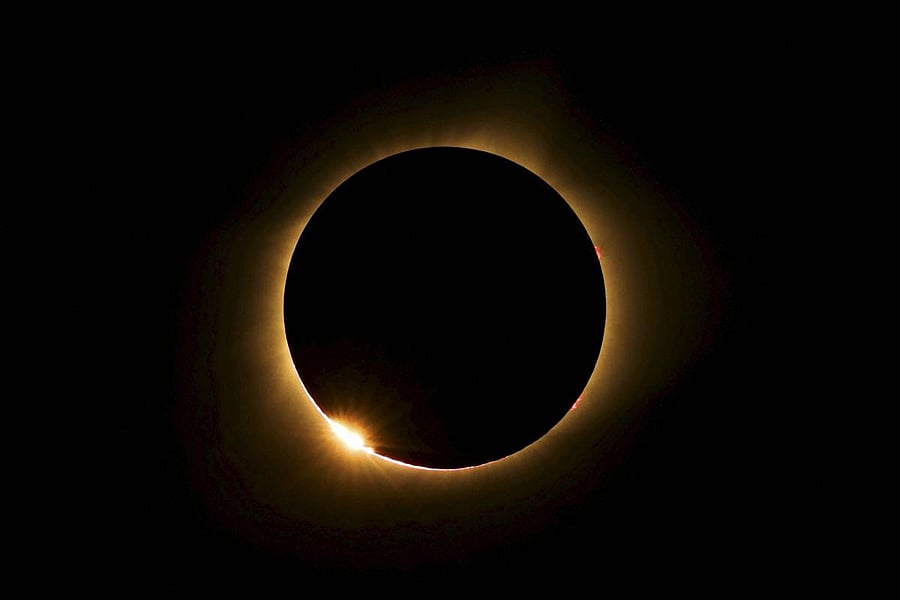
In recent years, there has been much excitement in the astronomical arena about the seminal discovery of gravitational waves — a dozen such events have been identified. More recently, a supermassive black hole in a giant galaxy has been imaged. The above phenomena are manifestations of Albert Einstein’s General Theory of Relativity (GTR), which he finally completed in late 1915.
While all these recent discoveries concerning gravitational waves and black holes have been hailed as a complete confirmation of Einstein’s GTR, it is interesting to recall that the very first spectacular experimental verification of the theory came during a total solar eclipse on May 29, 1919 — just a 100 years ago. This had to do with the gravitational bending of light. So in May, the scientific world celebrated the 100th anniversary of the confirmation of the GTR and gravity bending of light.
In his theory, Einstein considered the problem of what happens to light when it passes near a large massive body, like the Sun. He predicted that a light ray grazing the Sun’s surface should be deflected (or bent) by the solar gravitational field by 1.75 arc-seconds. This is of course a very small angle, as a one degree angle is 3,600 arc-seconds. Astronomical techniques at the start of the 20th century were already developed enough to measure such small angular dimensions.
The total solar eclipse of May 29, 1919, which had a long duration of around six minutes provided a good opportunity and two independent teams undertook the expedition to measure positions of the stars near the limb of the Sun, during the totality.
Only during a total solar eclipse is the sky dark enough for stars to be photographed in the vicinity of the Sun, revealing the grazing effects of solar gravity on starlight. Through the highest quality observations that technology permitted that time, the astronomical teams had to determine whether direct starlight was bent by the Sun’s gravitational field and by how much. Sir Arthur Eddington prepared two teams — one to Sobral (Brazil) and the other to Principe (Africa) as the total eclipse would be visible in these continents.
The longer duration eclipse provided enough time to take many photographs. The extremely complex measurements were made with an accuracy of about 20-30%. The results were consistent with Einstein’s prediction. What was really remarkable was that Newton’s gravitational laws, which dominated science for 300 years, predicted a value for this light deflection due to solar gravity.
The estimate of light deflection in Newton’s theory was made by Johann Georg von Soldner as far back as 1801. The value is 0.88 arc-seconds, just half of that predicted by Einstein’s new theory. Taking into account observational errors, the eclipse result agreed with Einstein’s prediction. This led to a big boost to Einstein and his GTR and the Newtonian gravity had to be changed. Overnight, Einstein became the greatest celebrity scientist of his time.
The idea of testing the theory had existed even during earlier solar eclipses; in 1916, the World War prevented trips while in 1918, clouds interfered in the observations.
A total solar eclipse is a unique spectacle occurring only in the Earth-Moon system. No other location in the solar system provides this spectacle. So, in a way, Einstein was lucky he developed his theory here. An ‘ET’ Einstein may not have had a total solar (or stellar) eclipse on his planet, delaying the verification by decades.
Gravitational lenses
Indeed, in the past few decades, the deflection of radiation by Sun’s gravity has been very precisely made with long baseline interferometry in the radio wavelength range with angular precision of less than a milliarc-second using, for instance, the luminous quasars 3C 273 and 3C 279 when they are eclipsed by the Sun.
Light bending by gravity of celestial bodies has now become a powerful astronomical tool in the form of so-called gravitational lenses. Eddington in 1920 and Einstein himself in a 1936 paper pointed out that stars can act as gravitational lenses. Swiss astronomer Fritz Zwicky subsequently noted in 1937 that a whole galaxy can be an effective gravitational lens. Apart from the lensing effect being stronger for larger masses, it would also be maximal if the light source, the gravitational lensing object and the observer are all arranged in a line.
In this case, the image of the source is a ring of light. Like in familiar optical systems, gravitational lensing could produce multiple images of the object (the Einstein cross!). There could be two images lying on the plane containing source, lens and observer.
Luminous objects at large cosmic distances could be gravitationally lensed by intervening massive galaxies or galaxy clusters and appear highly amplified. This has led to observations of distant quasars and faint faraway galaxies. Gravitational lensing has become a useful tool to detect even distant exoplanets, compact objects in the galactic halo (microlensing) and in the search for dark matter.
Like an optical medium, gravity also slows down light. Radio signals from transponders at the orbit of Mars take a few hundred millionths of a second longer while traversing through the Sun’s gravitational field. This time delay was also observed in the Cassini Saturn probe, verifying Einstein’s theory to high accuracy.
In short, the effects of gravity on light are profound and are continuing to yield many new results. All this started with the total solar eclipse, a hundred years ago, in the month of May.
(The author is with Indian Institute of Astrophysics, Bengaluru)